Minnesota Insects
Butterflies and Moths
Order Lepidoptera |
Lepidoptera is the order of insects that is characterized by having four large wings; mouthparts adapting for sucking, the proboscis in the form of a long coiled tube; and wings and body completely or mostly covered by scales. The order includes butterflies, skippers, and moths. There are about 174,250 known species in 126 families worldwide, 12,423 species in 82 families in North America north of Mexico. There are at least 161 butterfly species and 370 moth species found in Minnesota. |
Migratory Butterflies |
|||||
Many butterfly species scatter in a random direction soon after emerging as an adult. This is dispersion. Some butterfly species move permanently in one direction following a food source. This is emigration. Most butterfly species do not undertake a seasonal, long-distance (more than 125 miles), north-south journey. This is migration. Some adult anglewings (Polygonia spp.) and tortoiseshells (Nymphalis spp.) spend the winter in Minnesota as adults. They wedge themselves into small crevices in trees or human buildings. They sometimes fly about on warm sunny days in the dead of winter. They mate in early spring. Most other butterflies overwinter within their chrysalis. There are at least twelve butterfly species that cannot survive the harsh winter and migrate south each fall: American lady (Vanessa virginiensis) Occasionally, a migratory butterfly whose usual summer range does not extend this far north will stray into Minnesota. All of the following butterflies are migratory and have been reported at least once in Minnesota: cloudless sulphur (Phoebis sennae) |
|||||
Recent Additions |
|||||
Hackberry emperor |
|||||
Hackberry emperor (Asterocampa celtis) is a medium-sized brushfooted butterfly, with a wingspan of Hackberry emperor is similar in appearance to its close relative, tawny emperor (Asterocampa clyton), also found in Minnesota. Hackberry emperor can be distinguished by its darker coloration, white spots near the tip of the forewing, a single black eyespot on the forewing, and single black bar and two separated black spots in the large central area of the forewing. |
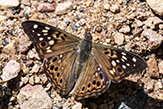 |
||||
Virginia ctenucha |
|||||
This common and widespread, colorful, medium-sized moth is the largest wasp moth in North America. It is found from mid-June to late July in moist, open, grassy fields and meadows. Although it is a day-flying moth it is also attracted to lights at night. This and other Ctenuchid moths have three adaptations that help to protect them from predators: the metallic blue color of the body mimics wasps which may be noxious to predators; caterpillars retain toxic chemicals from the plants they eat; and a specialized region on the thorax produces ultrasonic sounds which jam the sonar of moth-eating bats. This species is identified by the incomplete yellowish-orange collar and the broad wings with no markings. |
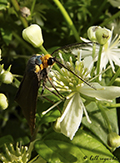 |
||||
| Photo by Bill Reynolds | |||||
Isabella tiger moth |
|||||
In its larval (caterpillar) stage, this tiger moth may be the most widely recognized moth in North America. Most of us have seen a woolly bear crossing a sidewalk, driveway, road, or parking lot. It has a densely bristly body that is black on both ends and orange in the middle. The adult is less conspicuous but equally distinctive. They are nocturnal and therefore rarely seen. Folklore says that the size of the orange band predicts the severity of the coming winter, with wider bands forecasting a milder winter. This means of forecasting is probably as accurate as the Farmer’s Almanac, though not as accurate as the National Weather Service. |
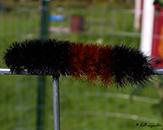 |
||||
| Woolly bear stage of Isabella tiger moth Photo by Bill Reynolds |
|||||
White admiral |
|||||
This is a common, large, brush-footed butterfly. In is found in forest edges and openings, on trails, and on roadsides. It is often seen sunning itself on gravel roads. Caterpillars are found mostly on birch, willow, quaking aspen, and chokecherry but sometimes also on other trees. Adults feed mostly on sap flows, rotting fruit, aphid honeydew, carrion, and dung, rarely on flower nectar. The appearance of this butterfly is distinctive and there are no similar butterflies in Minnesota. However, the range overlaps that of the red-spotted purple in the lower third of the state. Where the ranges overlap the subspecies interbreed and produce offspring with intergrading characteristics. |
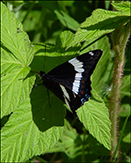 |
||||
| Photo by Bill Reynolds | |||||
Milbert's tortoiseshell |
|||||
This is a fairly common, medium-sized, brushfooted butterfly. It is found in woodland openings, open areas near woodlands streamsides, trails, and roadside ditches. In Minnesota, stinging nettle is the only host plant for the caterpillars. There are two broods each year. Adults of the second brood hibernate, sometimes in groups, in bark crevices or on human structures. When they emerge from hibernation in the spring they are pale and appear tattered. |
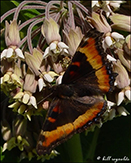 |
||||
| Photo by Bill Reynolds | |||||
Other Recent Additions |
|||||
polyphemus moth (Antheraea polyphemus) cecropia moth (Hyalophora cecropia) snowberry clearwing (Hemaris diffinis) one-eyed sphinx (Smerinthus cerisyi)
|
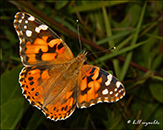 |
||||
| Photo by Bill Reynolds | |||||
abbreviated underwing (Catocala abbreviatella) |
|
||||
Acadian hairstreak (Satyrium acadica) |
|||||
American snout (Libytheana carinenta) |
|||||
Appalachian brown (Satyrodes appalachia) |
|||||
Arctic fritillary (Boloria chariclea) |
|||||
argos skipper (Atrytone arogos) |
|||||
Assiniboia skipper (Hesperia comma assiniboia) |
|||||
Atlantis fritillary (Speyeria atlantis) |
|||||
banded hairstreak (Satyrium calanus) |
|||||
bog fritillary (Boloria eunomia) |
|||||
bordered patch (Chlosyne lacinia) |
|||||
broad-winged skipper (Poanes viator) |
|||||
bronze copper (Lycaena hyllus) |
|||||
Chalcedon checkerspot (Euphydryas chalcedona) |
|||||
checkered white (Pontia protodice) |
|||||
cloudless sulphur (Phoebis sennae) |
|||||
Columbia silkmoth (Hyalophora columbia) |
|||||
Compton tortoiseshell (Nymphalis vaualbum) |
|||||
dainty sulphur (Nathalis iole) |
|||||
Dakota skipper (Hesperia dacotae) |
|||||
Dun skipper (Euphyes vestris) |
|||||
dusted skipper (Atrytonopsis hianna) |
|||||
eastern pine elfin (Callophrys niphon) |
|||||
fiery skipper (Hylephila phyleus) |
|||||
forage looper (Caenurgina erechtea) |
|||||
freija fritillary (Boloria freija) |
|||||
frigga fritillary (Boloria frigga) |
|||||
Garita skipper (Oarisma garita) |
|||||
goldenrod spindle-gall moth (Gnorimoschema gallaesolidaginis) |
|||||
gorgone checkerspot (Chlosyne gorgone) |
|||||
green cloverworm moth (Hypena scabra) |
|||||
green comma (Polygonia faunus) |
|||||
grizzled skipper (Pyrgus centaureae freija) |
|||||
hoary comma (Polygonia gracilis) |
|||||
inornate common ringlet (Coenonympha tullia inornata) |
|||||
Jutta arctic (Oeneis jutta) |
|||||
Karner blue (Lycaeides melissa samuelis) |
|||||
large marble (Euchloe ausonides) |
|||||
leadplant flower moth (Schinia lucens) |
|||||
Leonard's skipper (Hesperia leonardus) |
|||||
linden looper (Erannis tiliaria) |
|||||
little yellow (Pyrisitia lisa lisa) |
|||||
luna moth (Actius luna) |
|||||
Macoun’s arctic (Oeneis macounii) |
|||||
meadow fritillary (Boloria bellona) |
|||||
Mexican yellow (Eurema mexicana) |
|||||
Mormon fritillary (Speyeria mormonia) |
|||||
mournful thyris (Thyris sepulchris) |
|||||
mustard white (Pieris oleracea) |
|||||
North American gypsy moth (Lymantria dispar dispar) |
|||||
northern blue (Plebejus idas nabokovi) |
|||||
Olympia marble (Euchloe olympia) |
|||||
Ottoe skipper (Hesperia ottoe) |
|||||
Pawnee skipper (Hesperia leonardus pawnee) |
|||||
Persius duskywing (Erynnis persius) |
|||||
phlox moth (Schinia indiana) |
|||||
Phyllocnistis vitifoliella (no common name) |
|||||
pink-edged sulphur (Colias interior) |
|||||
Powesheik skipperling (Oarisma powesheik) |
|||||
purplish fritillary (Boloria montinus) |
|||||
racket-tailed emerald (Dorocordulia libera) |
|||||
red-disked alpine (Erebia discoidalis) |
|||||
sachem (Atalopedes campestris) |
|||||
satyr comma (Polygonia satyrus) |
|||||
silver-bordered fritillary (Boloria selene) |
|||||
silvery blue (Glaucopsyche lygdamus) |
|||||
silvery checkerspot (Chlosyne nycteis) |
|||||
simple wave (Scopula junctaria) |
|||||
sleepy orange (Abaeis nicippe) |
|||||
smokey eyed brown (Lethe eurydice fumosa) |
|||||
spring azure (Celastrina ladon) |
|||||
summer azure (Celastrina neglecta) |
|||||
taiga alpine (Erebia mancinus) |
|||||
tawny crescent (Phyciodes batesii) |
|||||
tawny emperor (Asterocampa clyton) |
|||||
toothed somberwing (Euclidia cuspidea) |
|||||
Uhler’s arctic (Oeneis uhleri varuna) |
|||||
Uncas skipper (Hesperia uncas) |
|||||
western tailed-blue (Cupido amyntula amyntula) |
|||||
white slant-line (Tetracis cachexiata) |
|||||
white-marked tussock moth (Orgyia leucostigma) |
|||||
white-striped black (Trichodezia albovittata) |
|||||
Whitney“s underwing (Catocala whitneyi) |
|||||
yellow-collared scape moth (Cisseps fulvicollis) |
|||||
zebra swallowtail (Eurytides marcellus) |
|||||
|
|||||
| 46 | |||||
![]() = Profile
= Profile
![]() = Photo
= Photo
![]() = Video
= Video
Capitalization of Common Names
Insect scientific names are governed by the International Commission on Zoological Nomenclature (ICZN). Vernacular (common) names are not. In an attempt to “assure the uniformity of (common) names of common insects” the Entomological Society of America (ESA) published Common Names of Insects and Related Organisms. ESA has no rule or guideline that addresses capitalization of common names. However, the database of common names published by ESA does not capitalize common names. National Center for Biotechnology Information (NCBI) also uses uncapitalized common names. Most other sources, including ITIS, BAMONA, Odonata Central, and the Peterson Field Guides, capitalize common insect names. MinnesotaSeasons.com will adhere to the convention followed by ESA and NCBI.
Last Updated:






















































